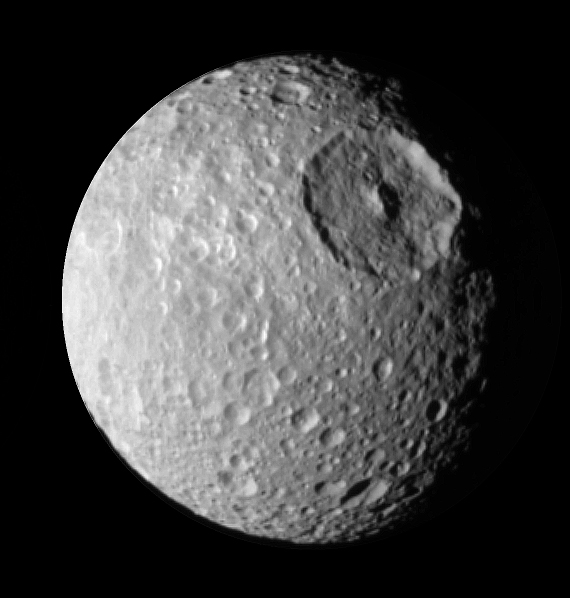Mimas << MY muhs >> the seventh largest moon of Saturn, features a giant crater about one-third the satellite’s width. Mimas has an icy surface heavily marked by impact craters. Scientists consider Mimas to be an old satellite because its surface shows little evidence of recent geological activity. Old satellites are typically darker than young satellites. However, Mimas remains bright because its surface consists primarily of relatively clean water ice. Mimas’s diameter measures 247 miles (397 kilometers). The moon orbits Saturn about once each day at a distance of around 115,300 miles (185,500 kilometers).

A vast impact crater named Herschel dominates the surface of Mimas. The crater measures about 80 miles (130 kilometers) in diameter. It features a central peak that rises 4 miles (6 kilometers) above the crater floor. Scientists do not know for sure what kind of collision created the crater, but such a large impact probably nearly destroyed Mimas.
Mimas orbits relatively close to Saturn, within the planet’s outermost ring, the E ring. Scientists think that small, icy E-ring particles may coat Mimas, brightening its surface. The gravitational influence of Mimas creates a dark gap between Saturn’s brightest rings, the A and B rings. Mimas’s gravitational pull keeps the gap, known as the Cassini Division, relatively free of particles. The amount of light reflected by Saturn’s rings often overwhelms the amount of light reflected by Mimas. As a result, astronomers have difficulty observing Mimas from Earth.
Evidence suggests Mimas has an underground ocean of water. Mimas wobbles as it orbits Saturn. Astronomers think the pattern of wobbles could be explained by a large amount of liquid water inside the moon. Mimas does not closely resemble other moons thought to have underground oceans, such as Enceladus and Europa. However, scientists think that Mimas’s ocean formed more recently than the oceans of those moons.
The British astronomer Sir William Herschel discovered Mimas using a telescope in 1789. The United States Voyager 1 spacecraft flew by Mimas in 1980 and discovered the crater that later was named in Herschel’s honor. Voyager 1 also found a series of long grooves on Mimas’s surface that might be related to the impact that created the Herschel crater. The U.S. Cassini spacecraft visited Mimas in 2005. Cassini’s high-resolution images revealed details of the Herschel crater and of the grooves.
See also Cassini; Herschel, Sir William; Saturn.
